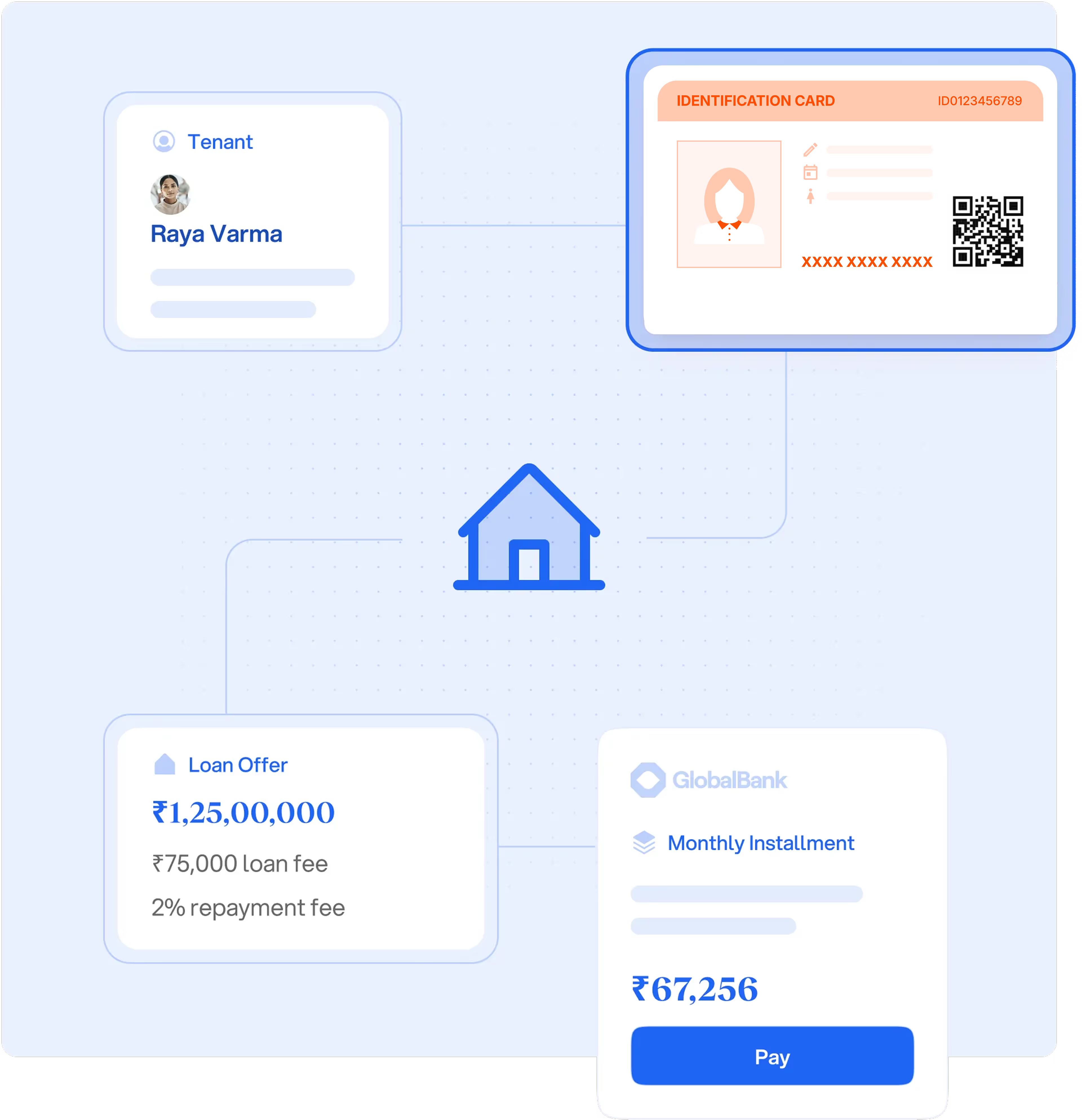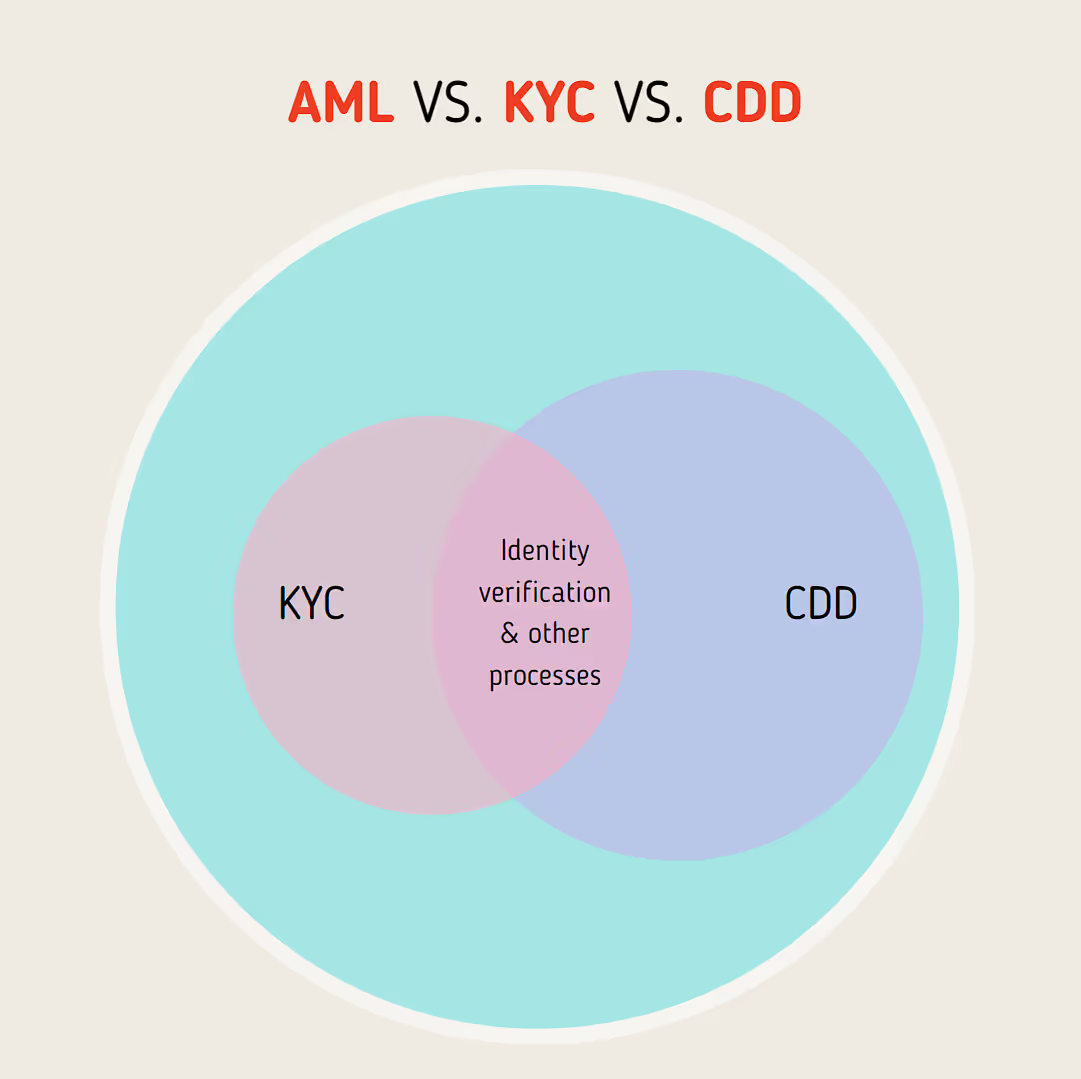The Building Blocks
to scale your Business
Neokred is the digital infrastructure layer that helps modern businesses scale by streamlining
profiling, payments, and privacy.



.svg)
.svg)












.svg)
.svg)









Smarter Profiling through Digital Identity Verification

profile



Scalable Payment infrastructure for businesses


Proudly Made In India
& TMS



competitive pricing


We Have Something in Store for All Businesses










Latest blogs
The Ultimate Fraud Detection Guide for Businesses to Reduce Financial Losses
Digital financial fraud in India has resulted in staggering losses of Rs 1.25 lakh crore over the past three years, with Rs 10,000 crore lost in 2023 alone. Fraud detection is critical for businesses to prevent various threats
Digital financial fraud has caused staggering losses of Rs 1.25 lakh crore on Indian businesses and individuals over the past three years, with 2023 alone accounting for over Rs 10,000 crore. These figures point towards a growing threat to businesses’ stability, regardless of the size or industry.
While digitalization has revolutionized the finance industry, it has also created new vulnerabilities. Fraudsters constantly evolve, exploiting gaps in security to target organizations.
Effective fraud detection, therefore, is no longer optional — it’s critical for an organization’s sustainable survival. Continue reading to understand how you can use fraud detection and prevention tools to safeguard your business.
What is Fraud Detection?
Fraud detection is the systematic process of identifying and preventing frauds within systems, applications, transactions, and data. It aims to protect businesses from financial losses resulting from deceptions such as money laundering, identity theft, and cyberattacks.
This process uses a range of fraud detection and prevention tools and techniques. These tools monitor behavior, transactions, and activities, constantly searching for patterns that could indicate fraud.
Industries such as Banking, Financial Services, and Insurance (BFSI), FinTech, healthcare, and government rely on these tools to minimize losses, maintain operational integrity, and ensure regulatory compliance.
Difference Between Fraud Detection and Prevention
While fraud detection focuses on detecting fraud in real-time, fraud prevention aims to stop fraud before it happens. Here are some major differences between the two:
Types of Frauds
Below are some key fraud types common in the country:
- Banking Fraud: Involves phishing, card skimming, and unauthorized online transactions.
- UPI and Mobile Payment Fraud: Scammers use fake UPI apps or QR codes to steal money.
- KYC and SIM Card Fraud: Fraudsters misuse fake KYC procedures or duplicate SIMs to access personal information and banking OTPs.
- Credit and Debit Card Fraud: Card skimming and data theft lead to unauthorized purchases or withdrawals.
- Investment and Ponzi Schemes: Fraudulent schemes promise high returns but collapse when new investments stop.
- Insurance Fraud: False claims and forged policies exploit insurance systems for financial gain.
- E-commerce and Return Fraud: Fraudsters abuse return policies by returning counterfeit or damaged goods.
- Loan Fraud: Stolen identities are used to apply for loans, leaving victims liable for repayment.
- Cyber and Social Media Fraud: Scammers impersonate individuals or businesses to trick victims into transferring money or sharing personal details.
How Fraud Detection Works
A robust fraud detection system integrates human oversight with technology and data analytics to detect and prevent frauds. Here’s what the general process looks like:
1. Data Collection:
The first step involves gathering data such as transaction history, customer information, access logs, and more. It serves as the foundation for fraud detection.
2. Data Analysis:
Once collected, the data is analyzed using a combination of statistical methods and AI techniques: some text
- Statistical Analysis involves:
- Regression Analysis: Examines the relationship between different variables to identify trends and predict future outcomes.
- Data Matching: Compares data sets to identify inconsistencies or unusual patterns.
- Statistical Parameters: Calculates metrics like averages and probability distributions to identify anomalies.
- AI Techniques include:
- Data Mining: Identifies hidden patterns and correlations within large data sets, which may indicate fraudulent activity.
- Neural Networks: Complex algorithms that mimic human brain function, enabling the system to recognize patterns associated with fraud.
- ML: Uses historical data to train models that can predict and identify fraudulent behavior in real-time.
3. Pattern Recognition:
The system applies algorithms to detect patterns in the data that could indicate fraud or the beginnings of fraud. Common patterns include:
- Unusual access time
- Irregular account activity
- Unusual transaction volume
4. Anomaly Detection:
Real-time systems continuously monitor transactions, flagging any deviations from established norms. Anomalies often signal potential fraud.
5. Alerts and Triggers:
When the system detects fraudulent activity, it generates alerts based on the severity of the threat. Depending on the risk level, it may automatically block transactions or require human intervention.
6. Case Management:
A case is created for investigation when fraud is detected. Analysts review these cases and take appropriate, pre-decided actions — such as suspending an account or contacting authorities.
7. Continuous Learning:
ML models must continuously be updated with new data and patterns to ensure they evolve with frauds.
8. Reporting and Compliance:
Fraud detection systems also generate reports that provide insights into the types of fraud detected and the effectiveness of prevention strategies. These reports are critical for regulatory compliance and auditing.
How Long Does Fraud Detection Take?
Let’s explore how long fraud detection typically takes, whether it happens in real-time or is caught after the fact. Understanding this timeline can help businesses plan their response and enhance their fraud prevention strategies.
Real-Time Fraud Detection
Real-time fraud detection techniques identify frauds shortly after they occur, leaving room for immediate responses, such as blocking transactions and contacting authorities. This approach is crucial in industries like financial services, FinTech, and e-commerce, where quick action can prevent financial losses.
However, real-time fraud detection is resource-intensive and complex. It requires continuous monitoring and sophisticated algorithms, which can lead to challenges like false positives — situations where legitimate transactions are flagged as fraudulent. This can inconvenience customers by triggering unnecessary security measures, such as multi-factor authentication (MFA).
Retrospective Fraud Detection
As the name suggests, retrospective fraud detection involves analyzing historical data (often from case management tools and fraud files) to identify patterns, anomalies, or loopholes that may have facilitated fraud.
While retrospective analysis provides the advantage of thorough examination and the opportunity to uncover root causes, it does not offer immediate protection. Fraud is identified after the fact, meaning the damage may already be done.
The most effective fraud prevention and detection strategy combines both real-time and retrospective methods. Together, they provide a comprehensive defense against fraud, balancing speed and accuracy with thoroughness.
Challenges to Fraud Detection
Companies face a number of challenges in combating fraud, including but not limited to:
Evolving Threat Landscape and Costs
Criminals continuously refine their strategies, employing sophisticated techniques like advanced persistent threats (APTs) and social engineering.
APTs are a complex and sustained cyberattack in which the intruder goes undetected to steal information. Social engineering involves manipulating people to perform actions they normally wouldn’t, for example, downloading a software they shouldn’t.
To manage these threats, organizations must constantly invest in new tools and expertise to keep pace, straining budget and resources.
Data Management and Technology Integration
The sheer volume and complexity of transactions demand real-time analysis of massive datasets, necessitating usage of advanced analytics and machine learning capabilities.
Updating the existing software to make sure it’s effective often requires complex integration with legacy systems, which is a resource-intensive process.
Balancing Security and User Experience
Stringent fraud prevention measures can introduce friction in user journey, potentially driving customers away.
Implementing adaptive security measures like behavioral biometrics can maintain strong security without compromising the customer experience.
Operational and Compliance Challenges
Companies must also navigate a complex web of regulations while maintaining effective fraud prevention, especially in cross-border challenges.
Using automated compliance solutions ensures businesses stay compliant with evolving regulations, reducing operational strain.
Benefits of Fraud Detection
Nearly 800 digital payment fraud cases are reported every day in India. In the previous fiscal year, 30,000 card and digital payment frauds worth around Rs 1,500 crore were reported. Fraud detection systems work to identify and prevent these frauds.
These systems are essential for minimizing financial losses and protecting the integrity of business operations. By proactively identifying and preventing frauds, they help maintain customer trust and protect the company’s reputation.
Additionally, they ensure compliance with regulatory standards, reducing the risk of legal repercussions and/or financial penalties.
Fraud Detection Tools, A Guide
When choosing fraud detection tools, you can pick from traditional and advanced fraud detection systems, or a combination depending on your requirements:
Traditional Fraud Detection Systems
These systems rely on established methods to identify frauds, providing a foundational layer of protection against well-known threats.
Rule-based Systems
Rule-based systems function by applying predefined rules to monitor and evaluate incoming data, such as transactions. Each data point is checked against these rules, which are designed based on commonly known fraud patterns.
When a transaction or activity doesn’t meet the set criteria, the system triggers an alert or takes action, such as notifying relevant parties. While effective for well-known fraud tactics, these systems may struggle with false positives and often fail to detect new or sophisticated techniques that don’t fit the established rules.
Anomaly Detection and Transaction Monitoring Systems
Anomaly detection assumes that fraud typically involves deviations from normal behavior. This approach focuses on identifying outliers in data streams collected from various sources, flagging any behavior that significantly deviates from a pre-defined baseline.
By continuously monitoring transactions, the system can quickly spot unusual patterns that may indicate fraudulent activity, offering a more dynamic defense compared to rule-based systems.
Advanced Fraud Detection Systems
Advanced fraud detection leverages a mix of AI, ML, and big data analytics to identify and detect fraud in real time.
AI-ML-Based Systems
Fraud detection models based on AI and ML identify complex patterns and relationships in vast amounts of data — quickly and often accurately — better than traditional rule-based systems.
Plus, not only can ML models be trained on historical data, they can also learn from new data in real time.
AI-based systems can then make real-time decisions, like approving or declining transactions as they occur. Banks use these systems to identify account takeover, money laundering, and insider trading frauds.
Internal Fraud Prevention Systems
These systems are designed to protect organizations from threats that originate from within. They are integrated directly into a company’s infrastructure, focusing on monitoring internal activities to ensure that employees and systems adhere to security protocols.
Third-party Cloud-based Providers
Cloud-based service providers, like Neokred, offer scalable, and often more specialized fraud detection solutions. They utilize advanced technologies and vast datasets from multiple industries, offering real-time fraud detection and updates on emerging threats.
By outsourcing to them, organizations can enhance their fraud prevention capabilities without the need for extensive in-house resources, ensuring a broader and often more robust defense against external threats.
Fraud Detection Best Practices
By implementing the following best practices, organizations can significantly enhance their fraud prevention capabilities:
Create a Potential Fraud Risk Profile
- Conduct a top-down risk assessment focusing on likely fraud areas and types.
- Develop risk profiles based on industry-specific and organizational threats.
- Use these profiles to define targeted fraud prevention and detection strategies.
Streamline KYC
- Implement automated digital identity validation.
- Strengthen due diligence procedures to verify customer authenticity.
Increase Organizational Awareness
- Communicate fraud detection and prevention programs clearly to all employees.
- Cultivate a culture of vigilance to mitigate internal fraud risks.
Integrate Fraud, Anti-money Laundering (AML), and Cybersecurity Operations
- Break down departmental silos to improve coordination.
- Leverage big data analytics for a unified approach to risk management.
Adopt a Continuous Improvement Cycle
- Regularly review and update your fraud profile.
- Incorporate industry changes and recent fraud cases into your strategy.
Methods for Enhancing Fraud Detection
Organizations can significantly improve their fraud detection capabilities by leveraging advanced technologies and data-driven approaches. Here’s how Neokred’s ProfileX employs cutting-edge methods to combat fraud:
- Real-time Monitoring: ProfileX continuously scans transactions as they occur, using ML algorithms to identify anomalies instantly.
- Network Analysis and Collaborative Intelligence: By analyzing relationships between users, merchants, and other entities, ProfileX uncovers hidden connections that may indicate fraud rings. Collaborative intelligence further enhances this by sharing insights across Neokred’s partner network to adapt quickly to emerging threats.
- User Profiling: ProfileX builds comprehensive user profiles based on behavioral patterns, transaction history, and even social media presence. This enables a more accurate risk assessment and allows for the detection of subtle changes that might signal account takeover or identity theft.
- Predictive Risk Scoring: Using advanced ML models, ProfileX assigns dynamic risk scores to each transaction. These scores consider a wide range of factors, allowing financial institutions to prioritize high-risk transactions for additional scrutiny or automated blocking.
- Fraud Profiling: An up-to-date database of known fraud tactics and profiles is maintained by ProfileX. By cross-referencing user behavior against these patterns, the system can quickly flag potential risks, even if the specific fraud method is new to your organization.
Fraud Detection and Neokred
Effective fraud detection systems prevent financial losses, enhance operational integrity, and improve regulatory compliance, while strengthening customer confidence. But as financial fraud continues to evolve, so must your defenses.
Neokred’s ProfileX exemplifies the cutting-edge of fraud detection technology. By leveraging real-time monitoring, collaborative intelligence, and advanced user profiling, ProfileX provides a comprehensive solution that adapts to emerging threats while maintaining a frictionless user experience.
Explore how it can fortify your fraud detection strategy and schedule a demo to see its capabilities in action.
What is Embedded Finance: Examples, Benefits and Opportunities
Embedded finance integrates financial services into platforms, offering seamless transactions, banking, lending, and more.
Have you ever bought something online with just one click or used a ride-sharing app to pay for your trip without pulling out your wallet? If so, you've experienced embedded finance in action.
Embedded finance is revolutionizing the financial landscape by seamlessly integrating financial services into non-financial platforms and applications. This innovation reshapes how businesses and consumers interact with financial products, creating new opportunities and challenges in the digital economy. But what exactly is it, and why should you care? Let’s find out!
What is Embedded Finance?
Embedded finance integrates financial services seamlessly into non-financial products or services, fundamentally changing how we interact with financial products daily. For instance, when you use a ride-sharing app, you're experiencing embedded finance in action - the payment for your ride is processed automatically without needing to take out your wallet or credit card.
This integration goes beyond just payments. Other industries increasingly incorporate various financial solutions into their core offerings. Retailers offer "buy now, pay later" options at checkout, effectively becoming lenders. Software companies provide invoicing and payroll services, taking on roles traditionally held by banks.
As a result, the traditional financial services industry is being reshaped. The need for standalone financial services is decreasing as consumers can access many banking, lending, and insurance products directly through the non-financial platforms they already use and trust.
Essentially, embedded finance enables businesses to integrate financial services closely related to their business:
- Banking services (like checking account balances)
- Lending (getting loans or credit)
- Insurance (protecting your purchases or activities)
- Investing (buying stocks or other financial products)
Instead of requiring users to leave a platform or app to complete a financial transaction, embedded finance brings those solutions directly to where customers are already engaged.
Examples of Embedded Finance
Embedded finance isn't just a fancy term – it's already part of many services you might use daily. Let's look at some examples:
1. Embedded Banking:
Embedded banking involves integrating essential banking services into non-financial platforms. Imagine a freelance platform that lets you manage your earnings and expenses in the app. That's embedded banking. It can include features like virtual accounts, balance checking, and money transfers.
Example: Uber's driver app includes a banking feature that allows drivers to open an account, receive payments, and manage their earnings directly within the app.
2. Embedded Payments
This is the most ubiquitous form of embedded finance. It allows customers to make purchases or transfers without leaving the platform they're using.
Example: Consider how easy it is to pay for an Uber ride. The payment happens automatically at the end of your trip – that's embedded payments in action. Another example is Amazon's one-click purchase option, which uses stored payment information to make buying quick and easy.
3. Branded Payment Systems
These are payment solutions co-branded between a non-financial company and a financial institution.
Example: The Apple Card, created in partnership with Goldman Sachs, is deeply integrated with Apple's ecosystem. It offers features like instant cashback and spending tracking directly in the Apple Wallet app, blending financial services with Apple's user experience.
4. Embedded Lending
This involves offering credit or loans at the point of sale, often in e-commerce settings.
Example: Klarna's "buy now, pay later" option, which allows shoppers to split payments into installments directly at checkout on partner websites.
5. Embedded Investing
Investment services integrated into non-financial platforms, allowing users to invest in stocks, bonds, or other financial instruments.
Example: Robinhood's API allows third-party apps to offer stock trading features directly within their platforms.
6. Embedded Insurance
Insurance products offered at the point of sale for relevant purchases.
Example: Tesla offers car insurance as part of the vehicle purchase process, using data from the car to determine premiums. Some car-sharing apps provide insurance as part of the rental process. Another example is how some travel booking sites offer travel insurance as part of the booking process.
What are the Key Components of Embedded Finance
Here are the critical components of embedded finance:
APIs (Application Programming Interfaces):
These are the technological backbone of embedded finance. Think of APIs as digital bridges that allow software systems to talk to each other. They facilitate the connection of a non-finance app with financial services. For instance, a payment API might allow an e-commerce site to process credit card transactions without building the entire payment infrastructure.
Open Banking Infrastructure:
This framework secures financial data sharing between different institutions, facilitating the integration of various financial services. For example, a ride-sharing app could use open banking APIs to connect directly with a user's bank account, allowing seamless payments without needing a separate payment processor. The app could also offer instant cash advances to drivers based on their earnings history, all within the same platform they use for their daily work.
Regulatory Compliance Frameworks:
Robust compliance measures are crucial to ensure legal and ethical operations. For example, a social media platform integrating peer-to-peer payment features must implement Know Your Customer (KYC) and Anti-Money Laundering (AML) checks. This might involve verifying users' identities through document uploads and automated background checks before allowing them to send or receive money, ensuring compliance with financial regulations while maintaining a seamless user experience within the app.
Data Analytics and AI:
These technologies enable personalized financial services and risk assessment, enhancing the user experience and improving decision-making processes.
Data Security and Privacy Measures:
Robust security protocols are crucial to protect sensitive financial information.
Embedded finance differs from traditional financial services in several key ways:
- Contextual Integration: Financial services are woven into the user's existing journey rather than being a separate, standalone service.
- Seamless User Experience: Customers can access financial services without leaving their preferred platform or app.
- Non-Financial Brand Relationships: Users interact with financial services through brands they already know and trust, even if those brands aren't traditional financial institutions.
- Data-Driven Personalization: Embedded finance can offer more tailored financial products and services by leveraging user data from the host platform.
How Embedded Finance Works
The mechanics of embedded finance rely on a complex interplay of technology, partnerships, and regulatory compliance. Here's a breakdown of how it typically functions:
- Technical Infrastructure: A robust API infrastructure is at the core of embedded finance. These APIs bridge the host platform (e.g., an e-commerce site) and financial service providers (e.g., payment processors and banks).
- Integration Process: The host platform integrates these APIs into its existing systems, allowing it to offer financial services seamlessly within its user interface.
- Data Exchange: When a user initiates a financial action (like making a payment), the host platform's system communicates with the financial service provider's system via the API, exchanging necessary data in real-time.
- Regulatory Compliance: Throughout this process, all parties must adhere to relevant financial regulations and data protection laws. This often involves Know Your Customer (KYC) checks, anti-money laundering (AML) procedures, and secure data handling practices.
- User Experience: From the user's perspective, this process happens seamlessly within the host platform's interface, often requiring just a few clicks to complete a financial transaction.
When you use an embedded finance service, all of this tech and teamwork come together to give you a smooth, easy experience. You might not see all the complex stuff happening in the background, but it's there, making everything work seamlessly.
Key Players in the Embedded Finance Ecosystem
Understanding the key players in the embedded finance ecosystem is crucial to grasping how this innovative approach to financial services operates:
1. Digital Platforms:
These companies integrate financial services into their existing offerings. They can be from various sectors:
- E-commerce platforms (e.g., Amazon, Shopify)
- Ride-sharing apps (e.g., Uber, Lyft)
- Social media companies (e.g., Facebook, WeChat)
These platforms leverage embedded finance to enhance user experience, increase customer loyalty, and create new revenue streams.
2. Financial Institutions:
Traditional banks and fintech companies are crucial in the embedded finance ecosystem. They provide the underlying economic infrastructure and often hold the necessary regulatory licenses. Some are adapting their business models to become "Banking-as-a-Service" (BaaS) providers, offering their banking capabilities via APIs for other companies to embed.
Examples: Goldman Sachs, BBVA, Green Dot
3. Embedded Finance Infrastructure Companies:
These specialized firms, like Neokred, provide the technological backbone enabling businesses to integrate financial services seamlessly. They offer:
- API integration capabilities
- Compliance and risk management tools
- Data analytics and reporting features
- White-label solutions for various financial products
Example: Neokred is a leading embedded finance infrastructure provider that enables businesses to seamlessly integrate financial services through robust API solutions, compliance tools, and data analytics. Their customizable white-label offerings accelerate time-to-market, enhance customer experiences, and ensure regulatory adherence, making them an invaluable partner in the evolving financial landscape.
Pros and Cons of Embedded Finance
Like any technological innovation, embedded finance comes with its own set of advantages and challenges:
Benefits:
- New Revenue Streams for Businesses: Companies can offer financial services without becoming entire banks, opening up new income sources.
- Enhanced Data Insights: Businesses can learn more about their customers' financial behaviors and preferences, enabling them to create more targeted marketing campaigns and develop new products that better meet customer needs. For instance, a retailer offering embedded payments could analyze purchase patterns to optimize inventory and create personalized promotions.
- Improved Customer Experience: Financial services become more seamless when built into platforms we use. 6 in 10 consumers want to transact with financial institutions that provide a single platform, such as social media or mobile banking apps. This demonstrates the rising acceptance and reliance on fintech solutions globally, indicating that consumers are increasingly integrating these services into their daily financial activities.
- Increased Financial Inclusion: People who might not use traditional banks can access financial services through familiar apps.
- Faster Innovation: New financial products can be developed and launched more quickly. This is possible because embedded finance platforms often use modular, API-based architectures. For example, a company could rapidly deploy a new lending product by integrating a third-party credit scoring API with its existing payment system rather than building the entire infrastructure from scratch.
Drawbacks:
- Regulatory Challenges: Companies must navigate complex financial regulations, which can be difficult for non-financial firms.
- Data Privacy Concerns: More sharing of financial data raises questions about security and privacy.
- Potential for Market Concentration: There's a risk that a few large platforms could dominate the space.
- Blurred Lines of Responsibility: When issues arise, it may not always be clear who is responsible—the platform or the financial service provider.
- Cybersecurity Risks: More integrated financial services could mean more potential targets for cybercriminals.
- Customer Trust Issues: Some people may hesitate to use financial services from non-traditional providers.
Comparison with Related Concepts
It helps to compare embedded finance with similar ideas in the financial world to get a clearer picture.
Embedded Finance vs. Open Banking
Let's look at how embedded finance stacks up against open banking. Both of these concepts involve bringing financial services closer to consumers, but they work in different ways:
- Open Banking is about banks sharing your financial data with other companies, with your permission. This helps create new services and increases competition among banks. Consider opening up the banks' data vaults to let other companies peek inside.
- Embedded Finance takes things a step further. It allows non-financial companies to offer financial services directly to the customer. It's like your favorite coffee shop app suddenly offering you a savings account or loan.
Open banking enables embedded finance, providing the data-sharing infrastructure that makes many embedded finance applications possible.
Embedded Finance vs. DeFi (Decentralized Finance)
Embedded finance and DeFi both seek to increase accessibility to financial services, but their techniques differ:
- Embedded Finance integrates typical banking services into non-financial platforms.
- DeFi uses blockchain technology to provide financial services without the need for centralized middlemen, frequently operating outside of established banking rules.
While embedded finance works to improve current financial services, DeFi aspires to establish whole new financial paradigms.
The Embedded Finance Market
The embedded finance market is experiencing explosive growth, with some projections suggesting it could reach $7 trillion in transaction value by 2026. Several factors are driving this growth:
- Increasing Digitalization: As more aspects of our lives move online, the demand for integrated digital financial services grows.
- Changing Consumer Expectations: Users now expect seamless, one-stop experiences in all their digital interactions, including financial services.
- Advancements in API Technology: Improved API capabilities make it easier and more secure to integrate financial services into various platforms.
- Regulatory Changes: Open banking initiatives in various countries have created a more favorable environment for embedded finance.
- COVID-19 Impact: The pandemic has accelerated digital adoption, including in financial services, boosting the embedded finance market.
Key market segments showing significant growth include:
- Embedded payments in e-commerce
- Integrated insurance offerings
- Embedded lending in various sectors
- Integrated investment services
The Future of Embedded Finance
As we look to the future, several trends and innovations are likely to shape the evolution of embedded finance:
- AI and Machine Learning: These technologies will enable more personalized financial services and better risk assessment. For example, an AI-powered budgeting app could analyze spending patterns and automatically adjust savings goals or suggest investment opportunities.
- Blockchain and Cryptocurrencies: We may see increased integration of blockchain-based financial services into traditional platforms. For instance, a social media platform could implement a blockchain-based loyalty point system, allowing users to earn, trade, and redeem tokens for real-world goods or services across multiple partnered businesses.
- Internet of Things (IoT): As more devices connect, we can see financial services embedded into a broader range of products and services. For example, smartwatches and fitness trackers could integrate with health insurance platforms, allowing users to earn discounts or rewards based on their activity levels and health metrics. This real-time data sharing could lead to more personalized insurance premiums and incentivize healthier lifestyles.
- Hyper-Personalization: Advanced data analytics will allow highly tailored financial products based on user behavior and needs. For example, a fitness app could offer personalized health insurance premiums that adjust in real-time based on activity levels and health metrics.
- Expansion into New Sectors: Embedded finance will likely penetrate more industries, from healthcare to education to government services. For instance, a university app might offer student loans or payment plans directly integrated with course registration.
- Regulatory Evolution: As embedded finance grows, we can expect regulatory frameworks to evolve to address new challenges and opportunities. We might see the emergence of specialized "embedded finance" licenses or new data protection laws tailored to integrated financial services' unique risks.
The rise of embedded finance will likely have significant implications for traditional financial institutions. Banks and other financial service providers may need to adapt their business models, potentially focusing more on becoming backend financial infrastructure providers rather than consumer-facing brands.
The Ultimate Anti Money Laundering Handbook for Fintechs/FIs
Explore the key strategies and regulations for anti-money laundering (AML) in fintech, ensuring compliance and protecting against financial crime.
Over $3.1 trillion in illicit money flowed through the global financial system in 2023, nearly equivalent to the market cap of Amazon and Meta combined, quite close to the nominal GDP of India (USD 3.5 trillion). Such staggering sums severely threaten the integrity and stability of our global financial system.
Financial crime doesn’t discriminate. However, fintech companies face an exceptionally high risk of being exploited. Their innovative services, which provide quick access to credit and streamlined account opening processes, can inadvertently create vulnerabilities in the system.
Regulators have developed a comprehensive set of laws called Anti-Money Laundering (AML) to combat this threat. Continue reading to understand how AML approaches money laundering and helps to maintain the trust and stability that underpin the global economy.
Understanding Money Laundering
To understand the ins and outs of AML, we first need to understand what money laundering is and how it works.
Money laundering is the process of disguising the source of illegally gained money (such as terrorist funding or drug trafficking) so it appears to have come from a legal source. It can have far-reaching economic, social, and security-related consequences globally.
The process essentially ‘launders’ this ‘dirty’ money ‘clean’, so it can be injected into the legal financial system.
Stages of money laundering
Money laundering typically occurs in three stages:
1. Placement
It involves introducing illicit funds into the legitimate financial system. Some standard methods of placement are:
- Smurfing (making multiple deposits below the AML reporting threshold)
- Commingling (blending dirty money with legit business revenues)
- Making payments to cash-based businesses like casinos to disguise the origin
- Paying off legitimate debt
2. Layering
Now these funds undergo a series of complex transactions so they’re buried within the financial system to disguise the owners’ identity. This process is called layering and it creates a convoluted audit trail.
For example, the funds may be wired from a US account to a shell company in the Cayman Islands, converted to bonds, sold, and transferred to a Swiss bank account within a short timeframe.
3. Integration
This involves reintroducing the now laundered money into the legit economy. The money is withdrawn and integrated into the economy. This is often done through:
- Real estate investments
- Acquiring luxury assets
- Securities trading
The global financial system has developed a coordinated approach in response to this growing threat — anti-money laundering.
Anti-Money Laundering Explained
Anti-money laundering is a comprehensive framework of policies, laws, and regulations designed to detect, prevent, and report money laundering. It addresses a wide variety of crimes, such as corruption, market manipulation, tax fraud, terrorism financing, and drug/human trafficking.
Anti-money laundering acts are created by global and local regulators and applied to financial institutions (FIs) and other regulated entities, such as:
- Banks and credit unions
- Insurance companies
- Asset reconstruction companies
- Gaming businesses and casinos
Different countries have different acts that FIs must adhere to.
India’s Key AML Acts
Prevention of Money Laundering Act (PMLA) is a critical anti-money laundering act in India, enacted in 2002 and subsequently amended multiple times, the latest being in 2023.
PMLA is enforced by the Enforcement Directorate (ED) under the Ministry of Finance. It works with the Financial Intelligence Unit-India (FIU-IND) to combat money laundering and terrorist financing, with the latter providing financial intelligence to the former.
India is also a member of the Financial Action Task Force (FATF) — a global organization with the aim “to develop policies to combat money laundering and to maintain certain interests.” It sets standards and promotes effective implementation of the AML. At the time of its formation, it had 16 members, though the number was 40 in 2023.
The Foreign Exchange Management Act (FEMA) was enacted to prevent money laundering through cross-border transactions. While its primary purpose is to regulate forex transactions, it limits the amount of foreign currency that can be taken out of or brought into India. Plus, it gives authorities the power to examine and investigate suspicious foreign exchange transactions.
A Brief History of PMLA
A brief history of India’s PMLA is shown in the following image:
The Importance of AML for FIs
In the wake of the 2008 financial crisis and the rise of financial crimes, regulators have tightened oversight on traditional FIs and fintechs. The fintech sector, in particular, faces increased scrutiny due to its rapid growth and innovative business models.
For instance, India’s fintech market alone is projected to reach $1.5 trillion by 2025. While this growth is driven by cutting-edge technologies, it also introduces new vulnerabilities that criminals may exploit. AML compliance is, therefore, substantial in:
- Combating financial crime: The UN Office on Drugs and Crime estimates that 2–5% of global GDP or $800 billion–$2 trillion is laundered annually. AML measures help detect various forms of financial crimes.
- Maintaining the integrity of the system: AML restricts bad actors’ access to financial resources, thus contributing to the overall stability and trustworthiness of the global financial system.
- Risk Management: Effective AML programs help institutions identify and mitigate risks associated with their products, services, and customer base.
Consequences of Non-Compliance for FIs
The stakes are high — over $485 billion were lost to fraud scams and bank fraud schemes in 2023 despite the current AML measures. Unsurprisingly, if the FIs and fintech don’t comply with the AML, regulators can impose sanctions and disciplinary actions:
AML Compliance Framework
To comply with the Anti-money Laundering Act, FIs need to register as reporting entities with FIU-IND and follow a set of requirements that form the foundation of an effective AML program:
- Create internal policies to detect and prevent laundering and signed by the board
- Appoint a compliance officer to ensure compliance
- Train the employees in AML compliance
- Have an independent review done by a third party
- Do customer due diligence to assess the risk of doing business with them
AML Solutions and Best Practices
In general, fintech and FIs are expected to take the following steps to ensure compliance with the anti-money laundering act:
Know Your Customer (KYC)
It’s the process of verifying the identity of a client:
- Collect and verify documents such as Passport, proof of address
- Regularly update the KYC information
- Categorise customers based on risk and apply enhanced due diligence (EDD) for high-risk customers
The goal is to ensure customers are who they claim to be and to assess potential risks of illegal intentions. It also allows FIs to trace each transaction to an organization.
Customer Due diligence (CDD)
CDD is a more comprehensive process that includes KYC but goes beyond it. It involves assessing the risk profile of the customers based on their background, financial status, and the nature of their transactions:
- Verify the identity of customers
- Identify and verify the beneficial owners of legal entity customers
- Understand the nature and purpose of customer relationships to develop a risk profile

It also includes ongoing monitoring of customer transactions to detect and report suspicious activities. If any unusual patterns or high-risk indicators are identified during this process, it may trigger the need for EDD. It involves more rigorous checks like:
- Obtaining additional information about the customer and business
- More frequent updates of customer information
- Closer scrutiny of the customer’s transactions
- Obtaining senior management approval to establish or continue the business relationship
Proper Reporting and Transaction monitoring
To the FIU, FIs must report suspicious transactions—Suspicious Activity Reports (SARs) and Currency Transaction Reports (CTRs).
Transaction monitoring systems detect unusual or suspicious transactions. They analyze transactions in real-time or batch mode to identify patterns that may indicate laundering. Compliance officers review the alerts generated by these systems. Report transactions above Rs 1 million to the FIU.
Wallet Screening
For cryptocurrency FIs, wallet screening involves verifying the source and destination of crypto transitions to ensure they aren’t linked to illicit activities. Wallets are screened against known blacklist wallets to identify high-risk transactions.
Use Case: Data-Driven Decision Making in AML
Data-driven decision-making can help FIs bolster their AML capabilities. By leveraging advanced analytics and comprehensive data aggregation capabilities using services like Neokred’s ProfileX, you can transform your AML efforts. Here’s how:
- Data aggregation: ProfileX aggregates transactional and non-transaction data from multiple sources, giving you a holistic view of customer behavior to help detect patterns indicative of money laundering.
- Risk-based assessments: Using advanced analytics, ProfileX can conduct risk assessments based on alternative data, such as behavioral insights. This enhances the accuracy of identifying high-risk customers.
- Real-time monitoring: ProfileX monitors customers’ transactions in real-time, allowing you to identify and respond to suspicious activities promptly.
Anti-Money Laundering and Neokred
AML compliance protects FIs and fintechs from reputational damages and regulatory penalties while fostering a secure financial system. However, while AML measures are necessary, traditional KYC processes can be cumbersome, leading to a poor user experience.
Neokred’s ProfileX addresses this challenge head-on, offering a streamlined approach to onboarding, KYC, and CDD using a name and mobile number. Then, it captures quality information from the documents and aggregates it in real-time to complete user profiles. It also offers insights into customers’ behavior, preferences, and creditworthiness to help detect potential fraud early on. API integration also minimizes disruption to existing operations.
Moreover, ProfileX is designed with regulatory compliance at its core, adhering to banking and data protection regulations. To explore how Neokred can improve your AML compliance and streamline customer onboarding, contact us here.







